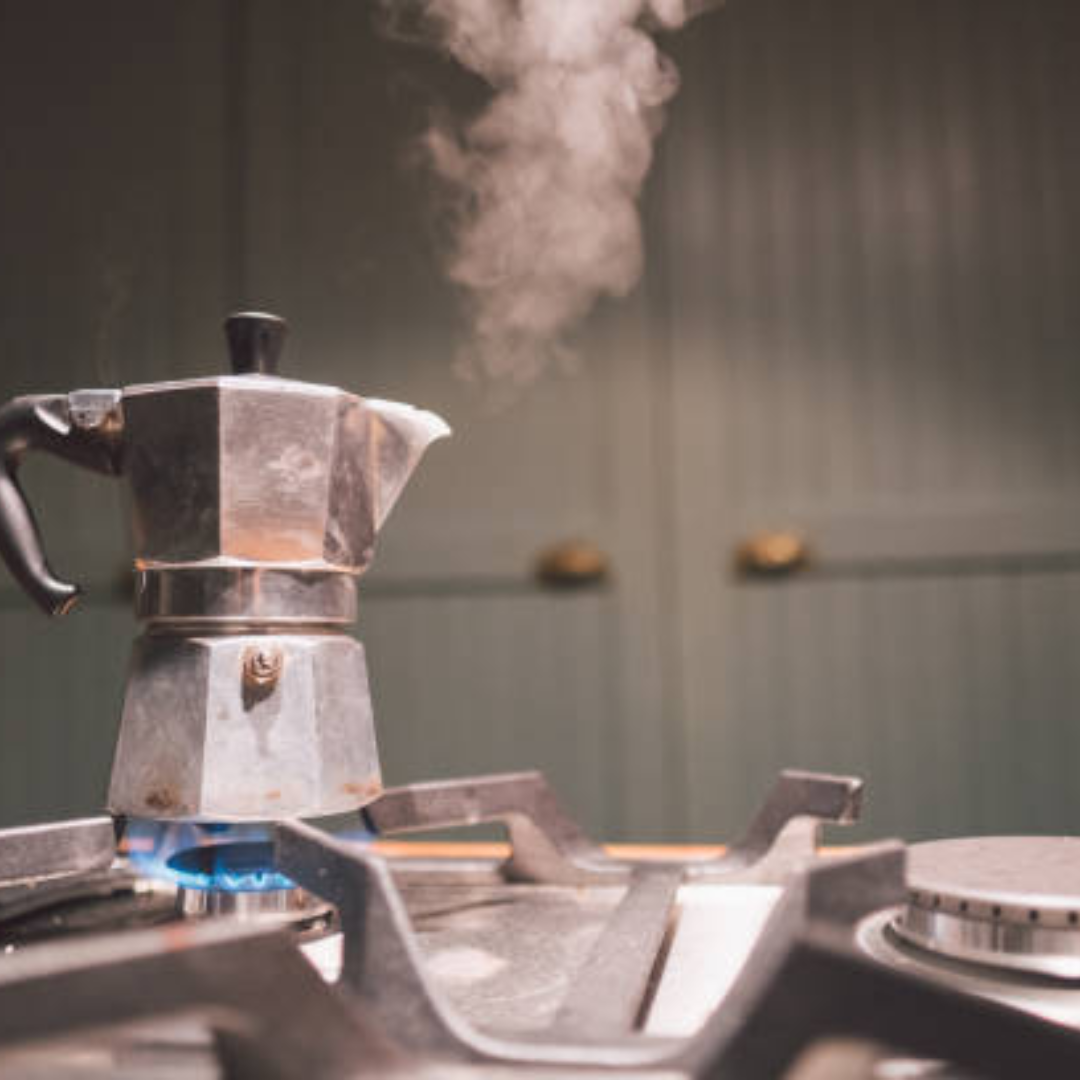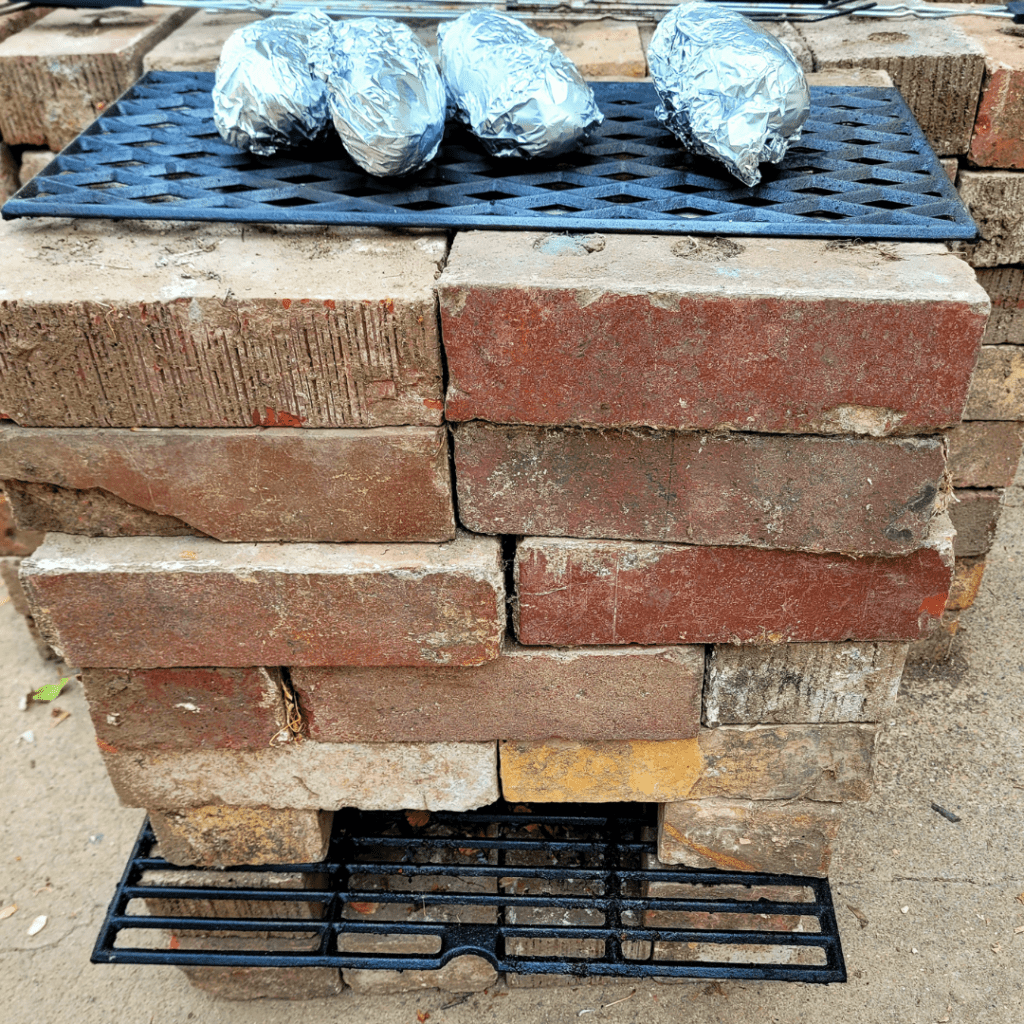If you’re looking to make your indoor kitchen more self-reliant and functional without depending on electricity, you’re in the right place. In this guide to the best off-grid kitchen tools, I’ll cover everything from manual food prep gadgets to off-grid cooking essentials you can use safely indoors. Whether you’re living off the grid full-time, prepping for power outages, or just simplifying your lifestyle, these indoor off-grid kitchen tools will help you stay prepared and well-fed without flipping a switch!
Why You Need Indoor Off-Grid Kitchen Tools
Living off the grid—or simply being prepared for emergencies—means rethinking how you cook and prepare food. Without access to traditional electric appliances, you’re going to need sturdy, reliable tools that can work manually or with minimal power. These tools are a game-changer for:
- Homesteaders
- Preppers
- Off-grid cabin dwellers
- City folks prepping for outages
- Anyone pursuing a simpler lifestyle
For me, cooking indoors off-grid has become second nature. During winter storms or everyday off-grid life, I rely on these tools constantly. Some I bought right away, others I wish I’d discovered sooner!
This is a pinnable post. Tap or hover over any image in this post to pin to your Pinterest Boards.
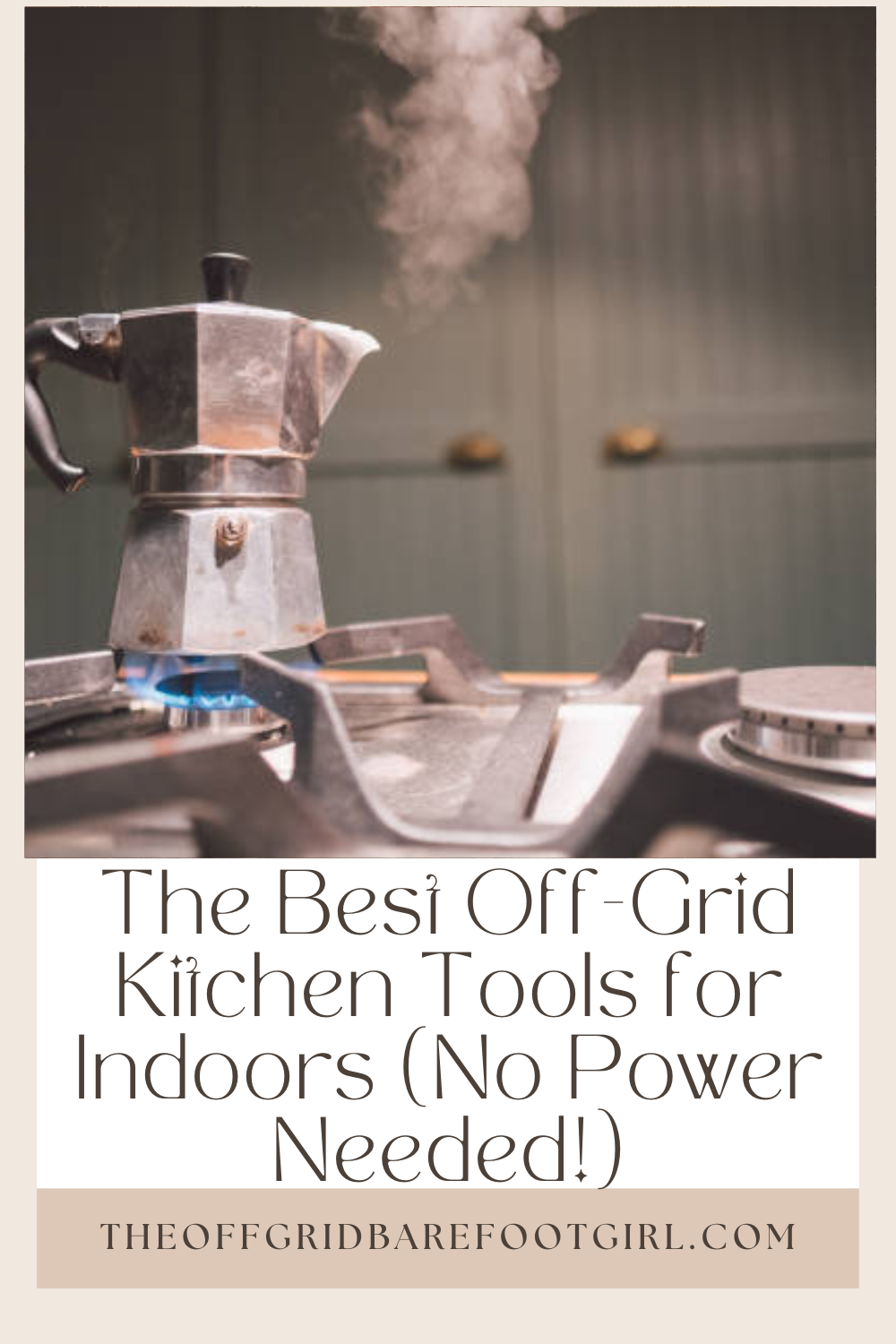
Manual Food Prep Tools
Hand-Crank Food Processors
A hand-powered food chopper saves time and elbow grease when prepping vegetables, herbs, fruits, or even cooked meats. These devices typically come with sharp rotating blades that are activated by pulling a cord or turning a crank. Models like the Brieftons Manual Food Chopper or the Chef’n Veggie Chop make quick work of onions, garlic, carrots, or even nuts in seconds, without a plug in sight. I love using mine to make salsa, chop herbs for soups, and even blitz cauliflower into “rice.” They’re compact, easy to clean, and take up very little counter space.
Manual Egg Beaters and Whisks
Whether you’re baking bread, making pancakes, or whipping up homemade whipped cream, a good hand-crank egg beater and some sturdy stainless steel whisks are a must. The rotary motion of a hand beater lets you beat eggs or cream butter without tiring your wrist, and it’s surprisingly fast. Stainless steel whisks come in handy for blending dry ingredients or stirring sauces on the stovetop. I’ve used both during long winter evenings when power was out, and honestly, I didn’t miss my electric mixer one bit!
Hand-Crank Grain Mill
Grinding your own flour off-grid is more than just practical—it’s empowering. With a durable hand-crank grain mill like the Country Living Grain Mill or Victoria Manual Grinder, you can turn wheat berries, corn, oats, and other grains into fresh flour on demand. I use mine weekly to grind hard white wheat for bread and soft wheat for muffins and cakes. The taste of freshly ground flour is unbeatable, and it allows me to store whole grains long-term, grinding only what I need. Look for mills with adjustable grind settings and heavy-duty construction for long-term durability.
Mortar & Pestle
Old-school but indispensable, a mortar and pestle set is one of those tools that surprises you with its versatility. It’s perfect for grinding whole spices, mashing garlic, mixing dry rubs, or crushing fresh herbs for pesto and marinades. The weight and friction do all the work, and there’s something satisfying about the tactile nature of using one. I prefer ceramic or granite models—they last forever and are easy to clean.
Box Grater and Mandoline Slicer
Shredding cheese, grating root vegetables, or slicing produce becomes easy with these classic, no-power tools. A box grater is a multitasker—it can grate cheese, zest citrus, shred carrots, or even prep potatoes for hash browns. Mandoline slicers, on the other hand, are great for uniform slices—think cucumbers, zucchini, or even homemade chips. While they require careful handling (watch those fingers!), they offer precise slicing and save loads of time during large-batch prep. Bonus: they run entirely on elbow grease and work beautifully in any off-grid kitchen!
Off-Grid Cookware and Indoor Heat Sources
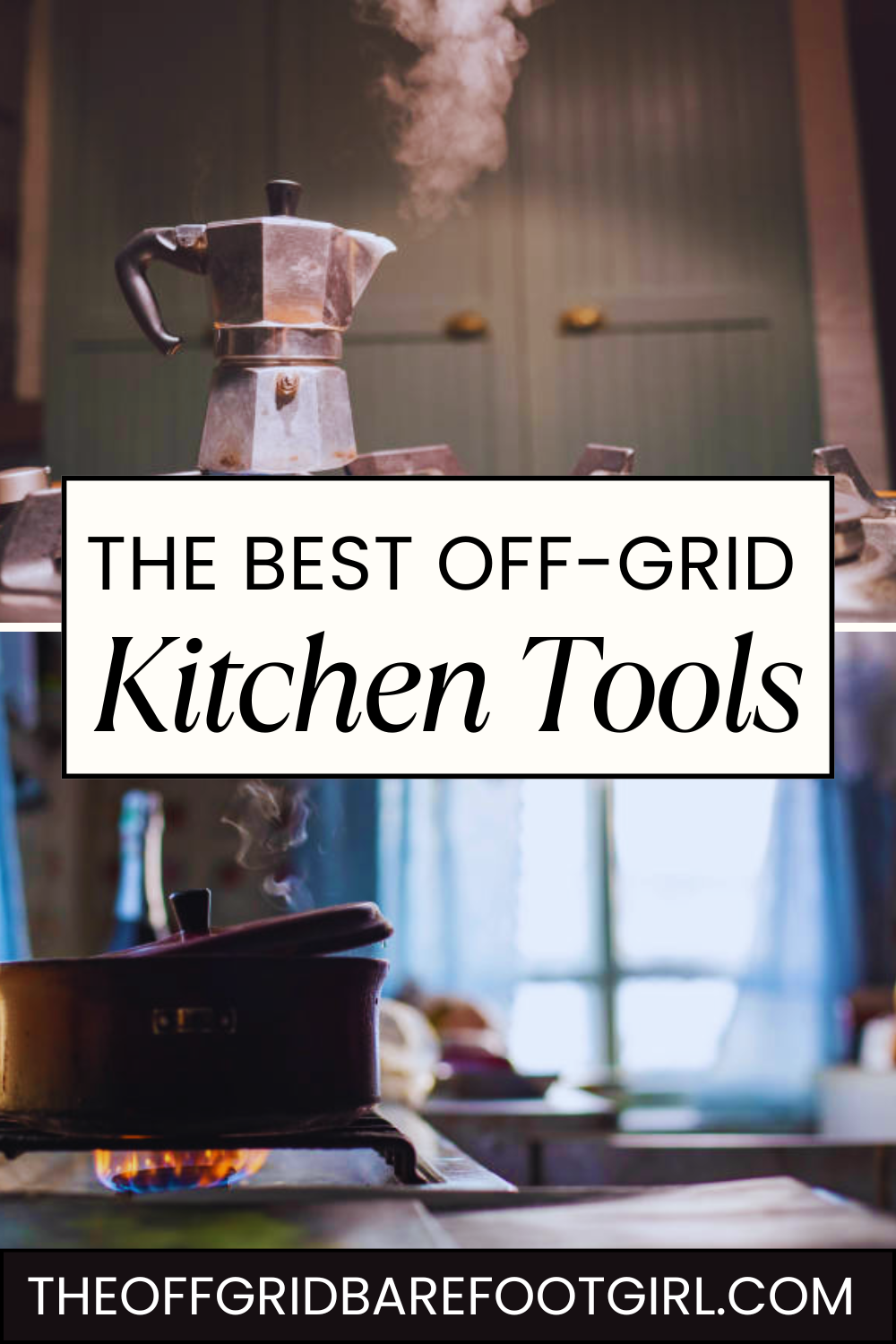
Cast Iron Skillets and Dutch Ovens
Cast iron skillets and Dutch ovens are absolute workhorses in the off-grid kitchen—and for good reason. These heavy-duty pieces of cookware retain heat beautifully, making them ideal for slow, even cooking on a variety of alternative heat sources like wood stoves, propane burners, or even solar ovens on sunny days. Cast iron is nearly indestructible and can last for generations if properly cared for. I keep a well-seasoned cast iron skillet on hand for everything from frying eggs to searing meat and even baking cornbread.
It goes from stovetop to oven without missing a beat. My enameled cast iron Dutch oven is just as versatile—I use it for simmering soups, cooking hearty stews, and baking crusty loaves of bread right inside my wood stove. The even heat distribution and ability to hold temperature for long periods make cast iron an off-grid essential. Plus, it’s naturally nonstick when seasoned and completely free of synthetic coatings, which fits perfectly with a more natural, self-reliant lifestyle.
Butane Stove or Alcohol Burner
For those without a wood stove, having a reliable alternative heat source is crucial, and that’s where butane stoves and alcohol burners come in. Portable butane stoves, like the GasOne Dual Fuel Stove, are compact, easy to use, and provide a strong, consistent flame that’s ideal for everything from boiling water to frying eggs. Alcohol burners are another great low-tech option; they use clean-burning fuel like denatured alcohol and are often found in emergency or camping kits.
Both options are safe for indoor use as long as your space is well-ventilated and you’re taking precautions. Always cook near an open window or with a vent, and keep a carbon monoxide detector in your kitchen for added safety. I personally rely on my butane stove during times when my wood stove isn’t running, and it’s saved more dinners than I can count!
In my off-grid kitchen, my trusty gas range stove is the heart of it all. It runs on propane, which makes it completely independent from the electric grid—perfect for consistent indoor cooking year-round. Whether I’m simmering a hearty stew, pressure canning garden vegetables, or boiling water for my morning coffee, it performs just like a traditional stove. I love the control it gives me over the flame, which is especially useful for delicate tasks like making jam or tempering chocolate. With proper ventilation and safety in place, it’s been one of my most reliable tools for off-grid living.
Stainless Steel Saucepan and Pot Set
Essential for boiling, simmering, or heating water, a quality pot is the backbone of any off-grid kitchen. Look for stainless steel or enamel-coated options with a thick, heavy bottom to ensure even heat distribution, especially important when cooking over alternative heat sources like a wood stove, propane burner, or even a solar oven.
Thin pots tend to scorch food easily or heat unevenly, which wastes fuel and can ruin meals. I recommend investing in at least one medium and one large pot with tight-fitting lids, so you can handle everything from soups and stews to boiling water for tea or preserving jars during canning season.
Thermal Cooker
A thermal cooker is one of the most energy-efficient and underrated tools you can have in an off-grid kitchen. It works on a simple yet brilliant principle: heat retention. After you bring your food—like soup, stew, rice, or beans—to a boil using a stove or burner, you place the pot inside the thermal cooker’s insulated chamber. From there, the retained heat continues cooking your meal slowly over several hours without using any additional fuel or electricity.
It’s like a non-electric slow cooker, perfect for saving fuel, especially in the winter when resources are tight. I love using mine on busy days—I’ll start a pot of chili in the morning, tuck it into the thermal cooker, and by dinner, it’s hot, perfectly cooked, and ready to serve. There’s no risk of burning or overcooking, and it’s completely silent and safe to leave unattended. It also keeps food hot for hours, which is a huge bonus if you’re feeding people at different times throughout the day. This can happen when you have busy teens at home!
Non-Electric Beverage Essentials
Stovetop Percolator
Coffee lovers, rejoice—going off-grid doesn’t mean giving up your morning brew. In fact, it might just make it better. A stovetop percolator is a tried-and-true classic that delivers a bold, rich cup of coffee without any need for electricity. It works perfectly on any off-grid heat source, whether that’s a propane burner, wood stove, or even a campfire. The process is simple: just add water to the bottom chamber, place your ground coffee in the basket, and set it over the heat.
As the water boils, it cycles through the grounds to extract that deep, satisfying flavor. I’ve used mine for years and actually prefer it to modern drip coffee makers—it makes the kitchen smell amazing and gives you that hands-on satisfaction that comes with making things from scratch. Plus, percolators are durable, easy to clean, and come in various sizes, so you can brew enough for just yourself or the whole household. If you’re a serious coffee drinker living off-grid, a percolator isn’t just a luxury—it’s a necessity!
Manual Coffee Grinder
Grind fresh beans with a simple hand-crank coffee grinder and elevate your off-grid coffee game. There’s something deeply satisfying about the rhythmic motion of grinding your own beans each morning—it not only connects you to the process but rewards you with an incredibly fresh and flavorful cup. Electric grinders are convenient, sure, but a manual grinder gives you full control over the grind size, from coarse French press to fine espresso, all without relying on power.
Look for models with ceramic burrs, which last longer and grind more evenly than steel blades. I keep a compact stainless steel grinder in my off-grid kitchen, and it’s become part of my morning ritual. It’s quiet, dependable, and small enough to take camping or pack away in a bug-out bag. Plus, when you’ve ground your beans by hand and brewed your coffee over a wood stove or propane flame, it just tastes better—rich, earned, and completely self-reliant.
French Press or Pour-Over
You don’t need a fancy machine to enjoy a satisfying cup of coffee off-grid—just hot water and a simple brewing method. Whether you’re using a wood stove, propane burner, or even heating water over a campfire, there are several ways to brew rich, flavorful coffee without electricity. Pour-over cones, French presses, and even cowboy coffee methods all work beautifully with hot water alone. I often heat water in my kettle right on the wood stove, then use a stainless steel pour-over filter or French press for a smooth, bold brew.
This method is not only energy-efficient but also gives you complete control over every step of the process—from grind to water temperature—so you can dial in your perfect cup. Brewing coffee this way is slower and more intentional, but that’s part of the charm. It turns your morning coffee into a peaceful ritual, reminding you that off-grid living doesn’t mean sacrificing comfort—it just means getting back to the basics.
Indoor Food Preservation Tools
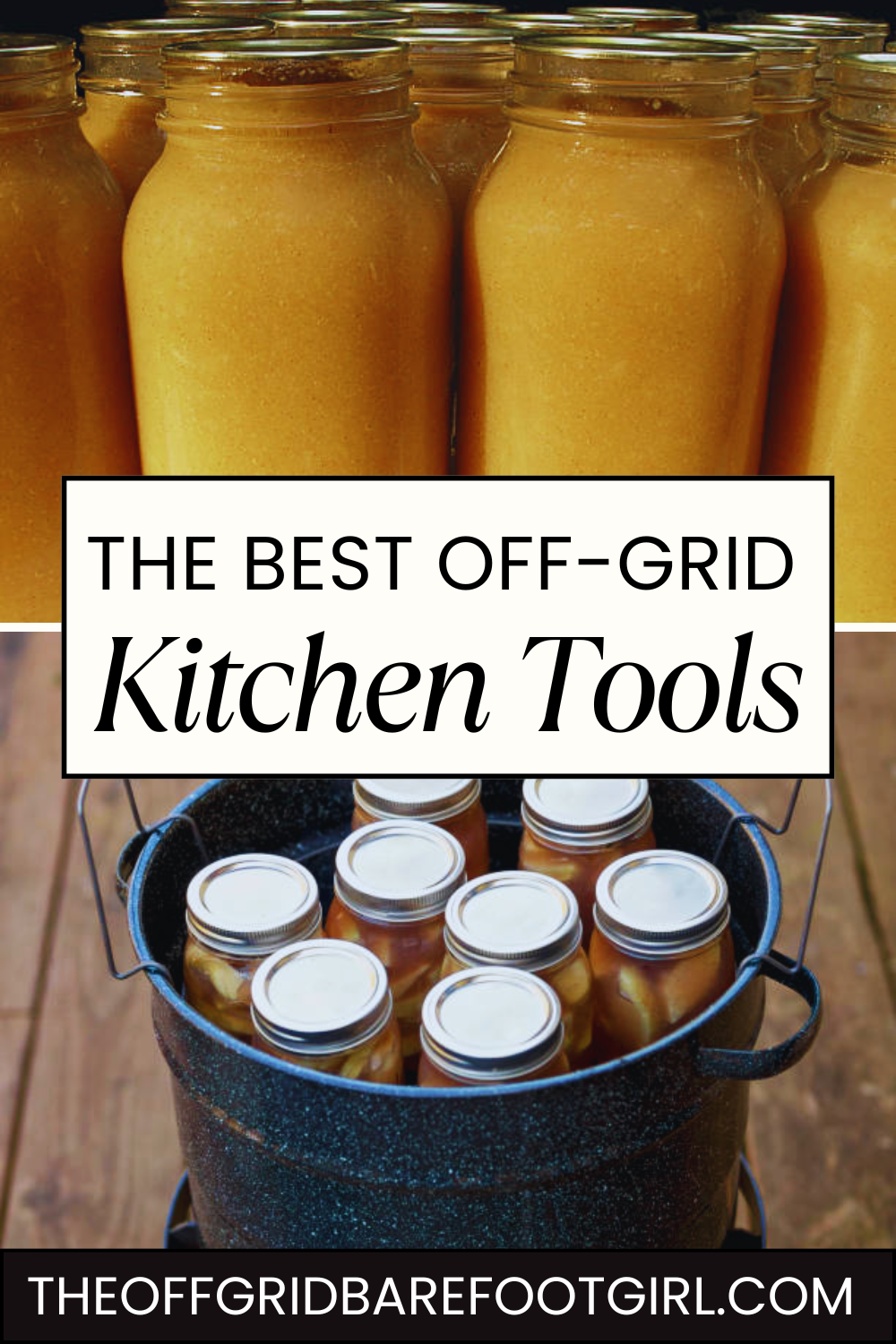
Water Bath and Pressure Canners
Canning is a cornerstone of self-sufficient, off-grid living—and yes, it’s completely doable indoors without electricity. You can safely and effectively preserve food using stovetop-safe canners right on your wood stove or propane burner. I personally use a water bath canner on my gas range stove throughout the harvest season to put up jars of homemade jams, pickles, tomatoes, and fruit syrups. As long as your heat source is steady and your canner reaches the proper boiling temperature, you can follow the same safe canning procedures you’d use on a conventional stove.
.For low-acid foods like meats, beans, and vegetables, a heavy-duty stovetop pressure canner—like the All-American or Presto models—can also be used, though I recommend using a heat diffuser for consistent pressure on a wood stove. Canning without power takes a little extra attention, but it’s incredibly rewarding. There’s nothing quite like hearing the satisfying “pop” of sealed jars lining your pantry shelves, knowing you preserved it all with your own two hands—no plug required!
Mason Jars and Accessories
Mason jars are the backbone of any off-grid kitchen. Whether you’re preserving a summer harvest, storing dry goods, fermenting vegetables, or packing leftovers, these versatile glass jars do it all. You’ll want to stock up on a variety of sizes—pint, quart, and half-gallon jars are the most useful. I always keep extra wide-mouth jars on hand for easy filling and cleaning.
But jars alone aren’t enough—you’ll also need the right accessories. Lids and rings are essential for sealing, and it’s wise to have plenty of extras in your pantry since lids are single-use for canning. A canning funnel makes filling jars cleaner and faster, while a jar lifter is a must-have for safely removing hot jars from boiling water or a pressure canner. Don’t forget a bubble remover and headspace measurer to ensure safe canning practices.
Over time, these tools become second nature, and your kitchen starts to feel like a true food preservation hub. I keep a large plastic tote filled with all my canning supplies so it’s always ready to go when I find myself with a basket of ripe fruit or a big haul from the garden. Off-grid or not, having the ability to preserve your own food year-round is one of the most empowering skills you can develop.
Fermentation Kits
Want to preserve food the ancient way? Fermentation is one of the oldest and most reliable methods of food preservation, and it’s completely off-grid friendly. With just salt, veggies, and time, you can transform cabbage into sauerkraut, cucumbers into pickles, and chili peppers into probiotic-rich kimchi.
Using a traditional fermentation crock makes the process easy and almost foolproof. These stoneware containers are designed to keep your ferment submerged and protected from air, thanks to a water-sealed lid that allows gases to escape without letting contaminants in. For a more compact and affordable option, airlock lids for Mason jars work just as well. These lids vent naturally while keeping mold and air out, making them perfect for small-batch fermenting on any countertop.
I always have a few ferments bubbling away in my kitchen, especially during garden harvest season. Not only does fermenting extend the shelf life of fresh produce without refrigeration, but it also adds gut-friendly probiotics and deep flavor to your meals. It’s one of those off-grid kitchen tools that feels old-fashioned, yet totally relevant for modern self-sufficiency.
Manual Vacuum Sealer
Some off-gridders use a hand pump vacuum sealer for dried goods, herbs, and even freezer bags—and it’s a surprisingly handy bonus tool. While not a necessity for every off-grid kitchen, a manual vacuum sealer can greatly extend the shelf life of your food without electricity. It works by manually pumping air out of specially designed vacuum bags, creating an airtight seal that keeps moisture, pests, and oxygen out.
I like using mine for storing dehydrated fruits, jerky, bulk herbs, rice, and beans. It’s a simple way to prep ingredients in advance and make the most of seasonal harvests or bulk food buys. Plus, vacuum-sealed packages take up less space—something every off-grid pantry can appreciate.
There are several styles to choose from: some come with a handheld pump and reusable bags, while others are compatible with Mason jar attachments, letting you vacuum seal dry goods right in your jars. It’s not as fast as an electric vacuum sealer, but it gets the job done quietly and efficiently—no outlet required. If you’re looking to build out your indoor off-grid food preservation setup, this tool is definitely worth considering.
Tools for Baking and Scratch Cooking
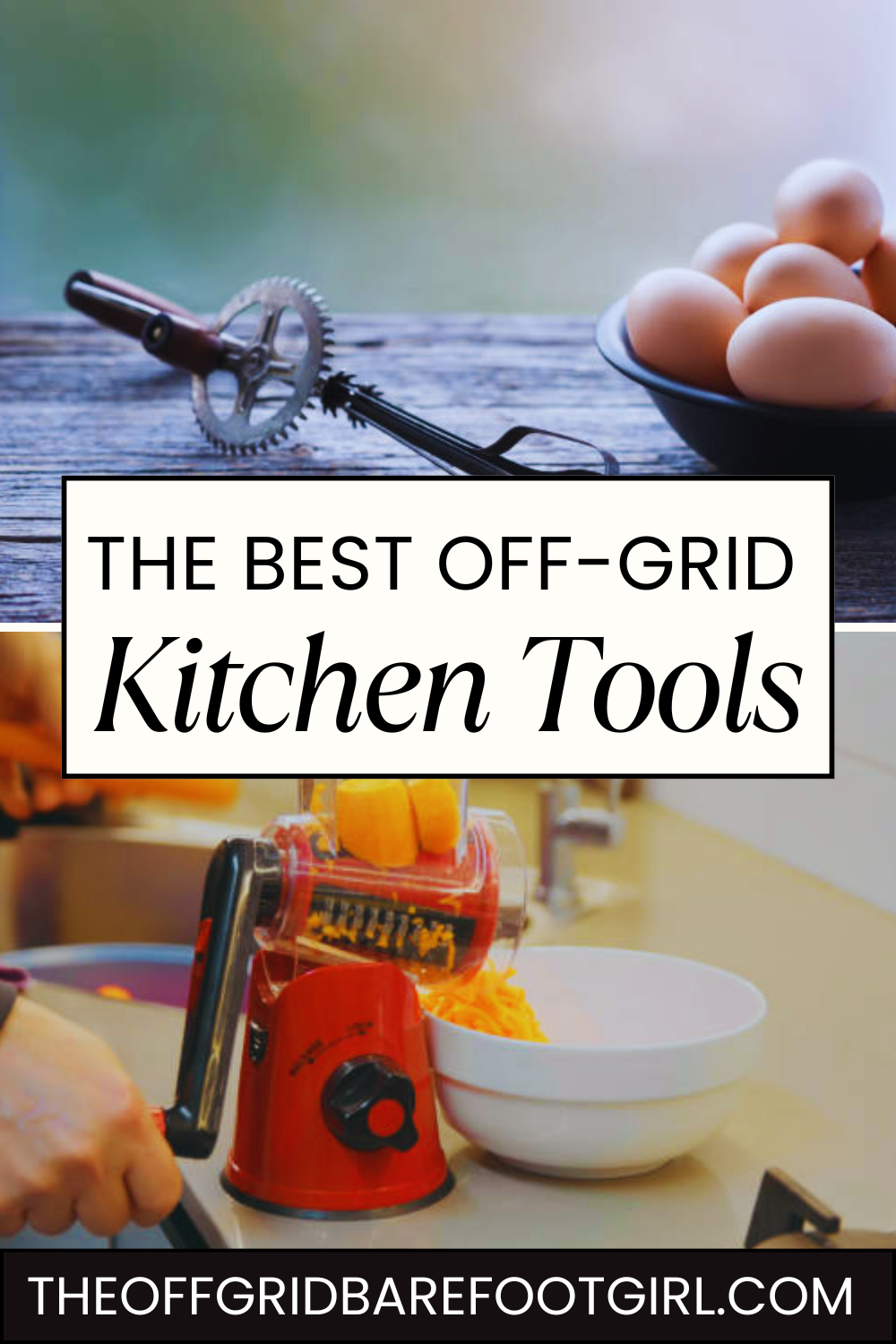
Danish Dough Whisk
This quirky-looking tool—a Danish dough whisk—makes mixing dough much easier than a spoon and is perfect for rustic, no-knead bread recipes. Designed with a unique looped wire head, the dough whisk glides through thick, sticky dough with ease, blending ingredients more thoroughly and with less effort than a wooden spoon or spatula.
It’s especially handy when baking off-grid, where minimizing dishes and maximizing efficiency is key. I use mine for everything from sourdough starters and artisan loaves to biscuit dough and even pancakes. Because it doesn’t overwork the dough, it helps preserve that lovely open crumb texture in bread. And the best part? It’s easy to clean—just rinse and wipe.
If you bake often or want to start baking more without electricity, a Danish dough whisk will quickly become one of your favorite go-to tools in your off-grid kitchen.
Proofing Basket
If you’re baking sourdough, a rattan proofing basket—also known as a banneton—is a must-have for helping your dough hold its shape during the final rise. These baskets are specially designed to support soft, sticky dough as it ferments, creating that classic round loaf structure and the beautiful spiral pattern you often see on artisan bread. The breathable rattan material also helps wick moisture away from the surface of the dough, encouraging a thin, crisp crust when baked.
Using a banneton is simple: just dust it with flour (or use a cloth liner) and place your shaped dough inside for its final proof. When it’s ready to bake, you gently flip the dough out onto your hot Dutch oven or baking surface. It’s a traditional technique that’s stood the test of time and pairs perfectly with off-grid baking methods—whether you’re using a propane oven, solar oven, or wood stove.
If you’re committed to baking sourdough off-grid, investing in a banneton makes a noticeable difference in both the appearance and texture of your loaves.
Manual Sifter
A flour sifter is an underrated but incredibly useful tool in the off-grid kitchen. It helps create soft, fluffy flour by breaking up clumps and aerating the flour, which is especially important when baking without modern conveniences like electric mixers. Sifting also ensures an even distribution of dry ingredients—like baking powder, salt, or spices—which leads to better texture and more consistent results in your baked goods.
When you’re working with home-milled flour from a manual grain grinder, a sifter becomes even more essential. Freshly ground flour often contains bits of bran or coarse particles, and sifting can help create a finer blend better suited for tender breads, pastries, or cakes. Some off-gridders prefer multi-layered sifters that allow you to separate fine flour from coarser meal, giving you more control over your baking process.
Simple, sturdy, and hand-powered, a flour sifter is a great addition to any indoor off-grid baking setup.
Cast Iron Bread Pan or Ceramic Bakeware
Use it in a Dutch oven, wood stove oven, or solar oven. Cast iron bakeware is the off-grid baker’s secret weapon. Whether you’re baking sandwich loaves, no-knead artisan bread, or rustic sourdough, a cast iron bread pan or Dutch oven helps retain and radiate heat evenly, creating that irresistible golden-brown crust and soft interior. I personally bake all my bread in cast iron—it’s durable, non-toxic, and virtually indestructible, which makes it perfect for the rugged needs of off-grid living.
The thick walls of a Dutch oven or cast iron loaf pan trap steam and heat inside, mimicking the environment of a commercial bread oven. That steam is essential for a crisp crust and proper oven spring. It’s also versatile: you can use your cast iron bakeware inside a wood stove oven, on top of a wood stove (with a trivet to protect the bottom), in a solar oven on sunny days, or even nestled into hot coals if you’re cooking outdoors.
And unlike glass or cheap aluminum pans, cast iron only gets better with age. A well-seasoned pan becomes naturally nonstick and develops a rich patina that adds flavor to every loaf. In my off-grid kitchen, it’s one of the few tools I rely on almost daily.
You can check out my other posts regarding cast iron cookware, including some of my favorite recipes!
Kitchen Storage and Pantry Tools
Airtight Containers and Jars
Keeping your dry goods fresh and pest-free is essential in an off-grid kitchen, where climate control might be minimal. Airtight containers and jars—especially glass and stainless steel—offer both durability and peace of mind. I personally prefer using wide-mouth Mason jars for flour, sugar, and dehydrated foods, while stainless steel containers work well for bulkier items like beans, pasta, and grains.
These containers create a strong seal that keeps moisture, air, and bugs out, which is especially important in areas with fluctuating humidity or where critters might sneak in. Plus, glass jars let you easily see what you have on hand, making pantry inventory quick and efficient.
Mylar Bags with Oxygen Absorbers
When it comes to long-term food storage, nothing beats the reliability of Mylar bags paired with oxygen absorbers. These are staples in any prepper’s pantry. I use them for everything from oats and rice to dry beans, flour, and powdered milk. The thick foil-like material blocks light and air, and when sealed properly with an oxygen absorber inside, it prevents oxidation and spoilage for years.
This is a game-changer for off-grid living where resupply isn’t always easy. Stack the sealed bags in plastic totes or food-safe buckets to protect them from rodents and physical damage, and you’ll have a compact, efficient, and long-lasting food reserve.
Stackable Pantry Baskets
When every inch of kitchen space counts, stackable pantry baskets can save the day. These are especially useful for organizing root veggies, snacks, canned goods, or smaller kitchen tools in tight cabinets or shelves. In my off-grid pantry, I use wire or plastic stackable baskets to separate food categories—like baking ingredients, dried herbs, and snacks—so I can grab what I need quickly without shuffling everything around.
They help prevent clutter, reduce waste from forgotten items, and let air circulate around fresh produce if needed. Bonus points if the baskets have handles for easy movement!
Hanging Produce Baskets
If your off-grid kitchen lacks counter space (like mine!), hanging produce baskets are a lifesaver. These tiered baskets can be suspended from the ceiling or a sturdy wall hook and are ideal for storing produce that doesn’t need refrigeration—onions, garlic, potatoes, squash, and even fresh herbs that are air-drying. I love how they add a cozy, country-style charm to the kitchen while being super functional.
The air circulation helps prevent spoilage, and keeping these items off the counter makes space for prep work and cooking. You can even dedicate a basket to fruits or fresh eggs if you’re collecting them daily from your chickens.
Bonus Off-Grid Kitchen Gadgets I Use Daily
Solar Lantern
Lighting becomes crucial when you’re living off the grid, especially during long winter nights or cloudy days when natural light is scarce. A good solar lantern is more than just a convenience; it’s a necessity. I always keep one hanging or charged up in the kitchen, so I’m never left trying to cook or wash up in the dark. Look for lanterns with multiple brightness settings and USB charging options as a backup.
Some even double as phone chargers. I’ve found them incredibly handy during power outages and late-night canning sessions. They soak up the sun during the day and keep things well-lit long after sunset.
Analog Kitchen Scale
Precision matters when you’re baking, fermenting, or preserving food, especially when you’re following recipes that require weight-based measurements instead of volume. A simple analog kitchen scale is a reliable, battery-free solution that works anywhere, anytime. I use mine constantly for measuring out flour, herbs, or even portions of meat for the dehydrator. It’s a small investment that pays off with more consistent results in your off-grid kitchen. And best of all, there are no batteries to die on you when you need them most.
Non-Electric Timer
When you’re not using a smartphone, microwave, or oven with a built-in timer, an old-fashioned wind-up kitchen timer becomes one of those surprisingly useful tools. Whether you’re timing a batch of cookies in a solar oven, letting bread rise, or keeping track of water bath canning times on your wood stove, a non-electric timer keeps things running smoothly. I like the kind with a loud ding—it’s easy to hear from across the cottage or while I’m outside working in the garden.
Fire-Resistant Dish Drying Mat
Handwashing dishes is a daily reality off the grid, especially when you’re heating water over a wood stove or propane burner. A good dish drying mat makes the job much easier. I prefer one that’s fire-resistant or made from heat-tolerant silicone or wool felt—just in case it ends up near a hot surface. It gives me a clean space to dry dishes without stacking them on top of each other and reduces the chance of breakage. Plus, it’s easy to wash and reuse, which is always a win when water and soap are used more sparingly.
Conclusion: Build Your Off-Grid Indoor Kitchen One Tool at a Time
Transitioning to off-grid indoor cooking doesn’t mean sacrificing quality, comfort, or flavor. With the right tools, you can create hearty meals, preserve food, and enjoy your kitchen without needing electricity. I recommend starting with a few essentials—like a cast iron skillet, a manual food chopper, and a coffee percolator—and building from there.
Each item on this list has earned a spot in my kitchen through daily use. I hope it helps you set up an indoor off-grid kitchen that’s not only functional but also a joy to cook in.
Have a favorite tool I didn’t mention? Share it in the comments! I would love to hear all about it!
These off-grid kitchen tools are essential for anyone living on raw land. Learn more about setting up your off-grid life in our comprehensive guide on How to Live on Raw Land.
Resources: Here are some helpful resources for further information.
- How to Create an Off-Grid Kitchen You’ll Love – By The Tiny Life
- All Electric Off-Grid Kitchen – By Gone with the Wynns
- Cooking In an Off-Grid Place – By NAZ Solar Electric
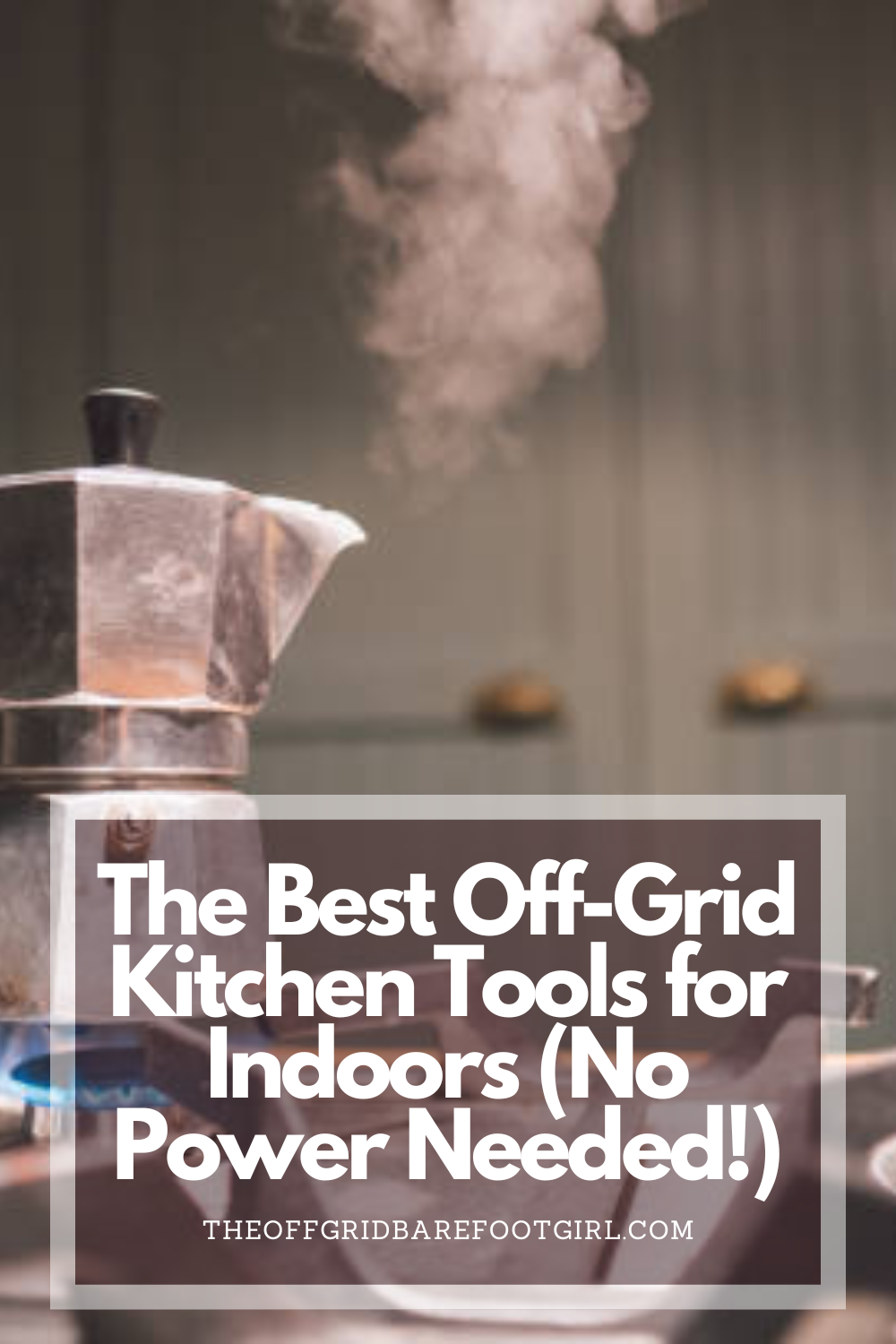
Frequently Asked Questions
1. Are butane stoves safe for indoor off-grid cooking?
Yes, but only when used in a well-ventilated area with a carbon monoxide detector nearby. Always follow the manufacturer’s safety instructions.
2. Can I use cast iron cookware on a wood stove?
Absolutely. Cast iron works perfectly on a wood stove and retains heat well, making it ideal for off-grid cooking.
3. What is the best off-grid tool for making bread?
A hand-crank grain mill, Danish dough whisk, and cast iron bread pan are my top three for baking from scratch.
4. What’s the easiest way to preserve food off-grid indoors?
Water bath canning and fermentation are two beginner-friendly methods that work well in an indoor, off-grid kitchen. I have a ton of water bath canning recipes for you to try throughout my blog!
Summary
I hope I have inspired you to live sustainably with these tips and products.
If you were encouraged by this post, I invite you to check out my FREE Printables Page for fun free printables, planners, and charts.
ENTER MY FREE Printables Page HERE
Here are some more of my gardening inspiration posts to check out!
DIY Solar Made Simple: How I Powered My Off-Grid Life with Practical Preppers!
Sleeper Cells in America: What You Need to Know Now!
How People Are Surviving in Broken Cities with Broken Systems
When the World Hurts, We Prepare with Purpose
How to Live On Raw Land: Everything You Need to Know!
How to Do Off-Grid Laundry with Eco-Friendly Laundry Detergent!
Hollywood on Fire! What Secrets Are In the Ashes?
FEMA Concentration Camps? Are Echos of the Past Returning?
How Likely Is a Russian EMP? One Pulse Could Black Us Out!
What Dark Secrets Lie in The Bird Flu Symptoms?
The Blackout Sun: Who Is Blacking Out Our Sunlight?
How to Bug-In During a Deep Freeze!
‘FOGVID-24?’ What’s in the Mysterious Fog That’s Making Everyone Sick?
From Snow to Sow: Plan Your Spring Garden Now!
11 Fun Ways to Brighten Your Spring Garden with Personality
Top 10 Spring Garden Crops to Harvest in 30 Days and Eat Now!
The Best Survival Crops for Caloric Survival
More Posts!
My Victory Garden: What I Learned from 5+ Years
Why Every Family Should Have a Victory Garden in Their Backyard Now!
The Best Perennials for a Long-Term Survival Garden
The Best Essential Oils for Plants That Repel Garden Bugs
How to Grow Green Garden Peas: Perfect Plump Peas!
Hugelkultur: Does This Epic Pioneering Method Actually Work?
9 Ways to Celebrate Earthing Day in Your Garden!
Gardening Indoors: Secrets of Growing Your Food Inside!
How to DIY a Milk Jug Drip Irrigation System!
Why Cedar Mulch Is The Perfect Natural Weed Barrier
Gardening Projects
Onions: How to Grow Onions for Storage
Peas: How to Grow Garden Peas for a Bumper Crop
Carrots: How to Grow Carrots for a Bountiful Harvest
Prep Your Garden for Spring Planting with These Expert Tips!
How to Grow a Prepper Garden to Survive and Thrive
The Best Garden Tools You Need for a Productive Season
Fastest Growing Vegetables for Your Survival Garden
How to Grow Marigolds As Pest Control In Your Vegetable Garden
Must-Have Tools for a Successful Balcony Vegetable Garden
How to Effectively Combat Powdery Mildew in Your Garden
The Best Tips for Organic Gardening
How to Release Ladybugs In Your Garden for Organic Pest Control
More Posts!!
The Best Garden Snail Control Strategies
The Best Spring Vegetables to Grow in Your Garden
Seed Starter Mix: How To Make Your Organic Seed Starter Mix At Home
How to Grow a Productive Canning Garden
How to Plant and Grow a Salsa Garden
Easiest Heirloom Vegetable Seeds to Grow Now
How to Use the Hand Twist Claw Tiller: Tackling Tough Soil
More Fun Gardening Posts to Check Out!
Planning Your Garden: How to Plan a Vegetable Garden: Expert Green Thumb Tips!
Winterizing the Garden: How to Winterize Your Vegetable Garden: Step-by-Step Checklist
Mulching the Garden: How to Make Leaf Litter Mulch
Grow a Pumpkin Patch: How to Grow a Pumpkin Patch in Your Backyard
How to Grow a Fall Garden: 9 Best Fall Crops
Clever Ways to Incorporate Indoor Composting into Your Home
How to Start Composting for the Garden: A Step-by-Step Guide
The Ultimate Guide to Composting in Your Suburban Backyard
Why I Built A Survival Garden in My Backyard
16 Best Medicinal Herbs to Grow in Your Garden Now
Blessings,
The Off Grid Barefoot Girl

